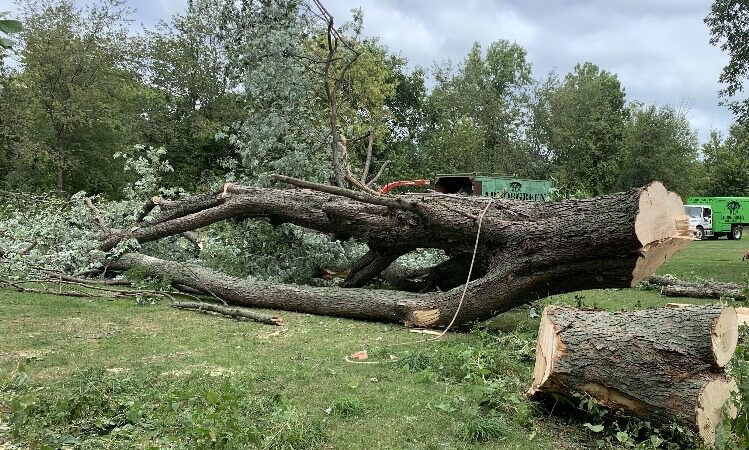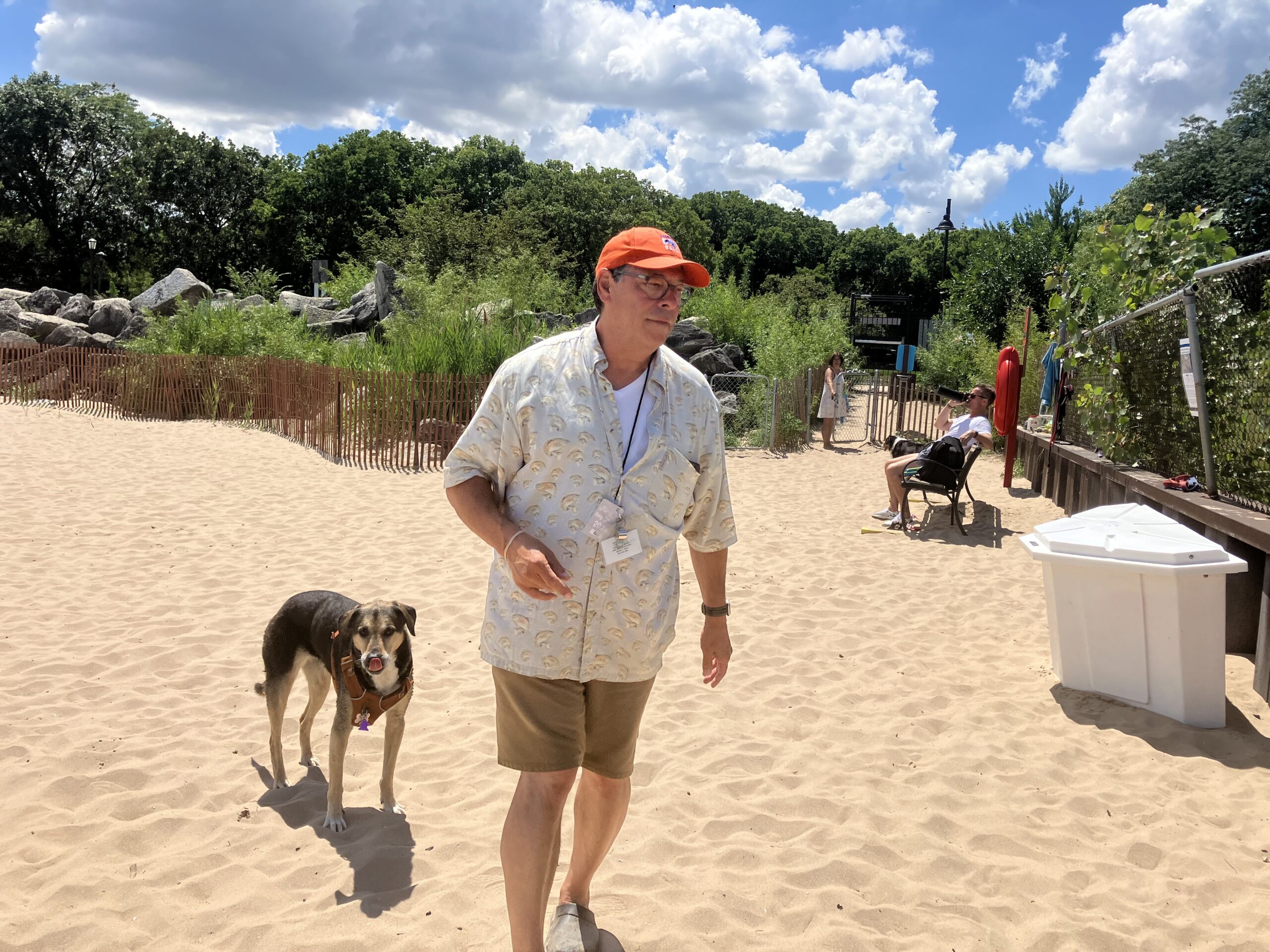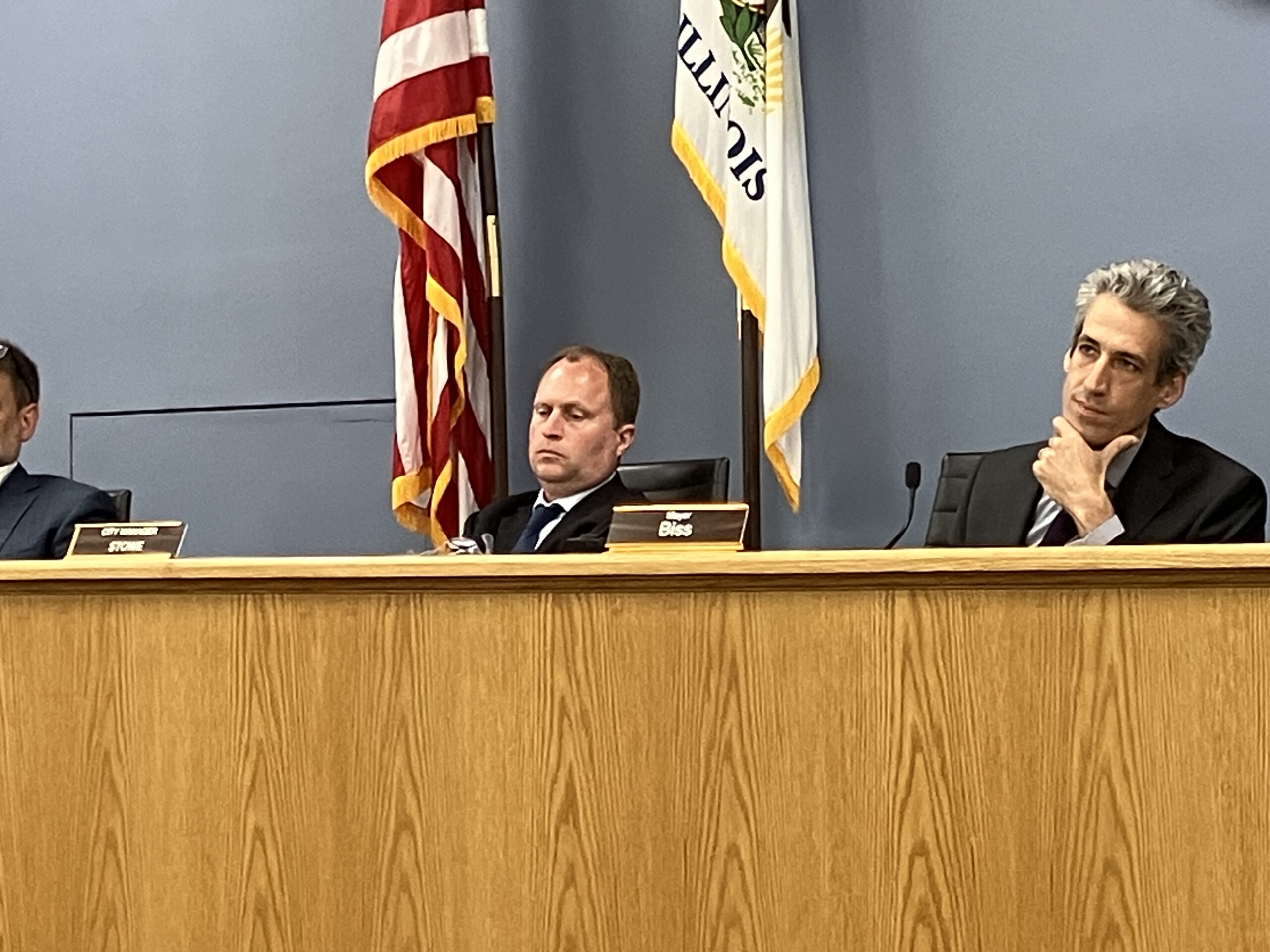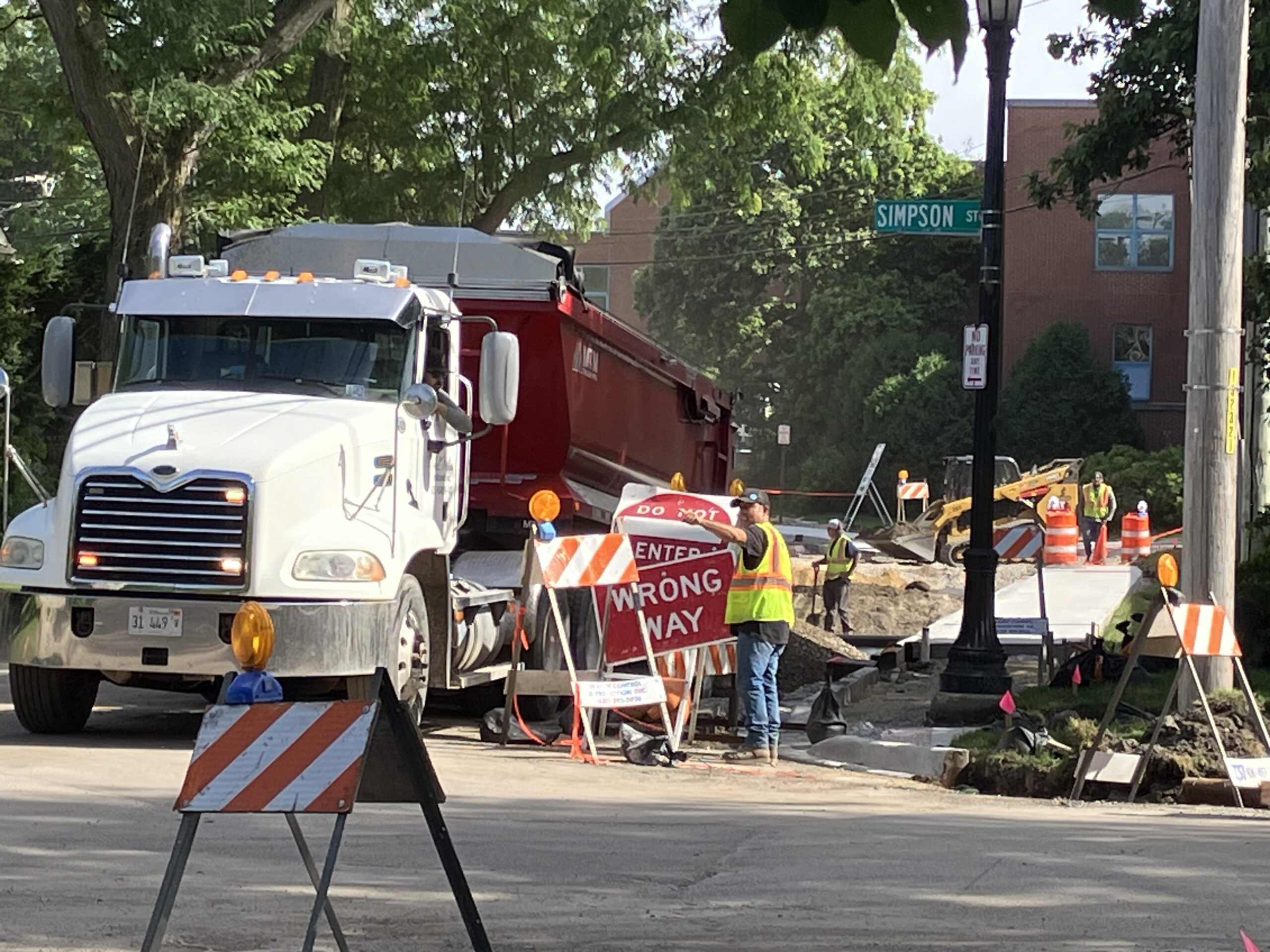By Bob Seidenberg
Some neighbors of Canal Shores Golf Course, upset to see three old trees on the course get chopped down, on Thursday charged the trees had been felled without necessary permits.
But Evanston Council Member Eleanor Revelle (7th Ward), who had initially concurred with neighbors and said that something “fell through the cracks,” on Friday said Canal Shores does have authority to pursue renovation work on its property, including tree removals, based on correspondence from the Metropolitan Water Reclamation District and a legal opinion from former Corporation Counsel Nicholas Cummings.
Revelle said after conferring with staff about the permit issue, the information appeared to support Canal Shores acting within its own authority.
On Thursday, Michelle Redfield, a member of the city’s Environment Board, met with Revelle after the three trees were felled Wednesday – two 60- to 70-foot silver maples, as well as a smaller silver maple.
Redfield said she had gone out to the course’s 17th fairway – near where the tree removal was taking place – but said Canal Shores representatives told her they had a permit that gave them the right to do work. “But there was nothing on there about tree removal,” she said.
“Really, we have a tree preservation [ordinance] for public trees,” Redfield told Revelle, “and it doesn’t seem like [it’s] being followed.”
Revelle offered some initial support for Canal Shores, noting, “Representatives have been in regular communication with city officials and also the MWRD [Metropolitan Water Reclamation District], which leases the property the golf course sits on to Evanston. They have an ecological plan from about six years ago. They talked about the important trees they wanted to save and what they wanted to remove.”
In response, Redfield suggested, “Maybe we had some people in the city involved, but we didn’t have the tree preservation ordinance people coming out and evaluating each of the trees before they were cut down.”
Revelle said that step “was never part of the conversation.” She indicated there would be a pause until next week “to give everybody a chance to get up to speed.”
Chain saws at 8 a.m.
Around 10 workers and about five trucks arrived at the golf course about 8 a.m. Wednesday to remove the trees, said Dave Ellis, a retired firefighter who lives across from the 17th hole where the tree cutting took place. Ellis said he came out Wednesday to see what was happening after hearing chain saws.
He said the trees were taken down by 10 a.m., and “they had everything cleaned up by 2:30 p.m.”

Ellis said three more trees were slated to be removed, but the work stopped after neighbors called the city, the Metropolitan Water Reclamation District and others to complain.
“If the process isn’t transparent, we don’t know what’s going on,” he told Revelle on Thursday. “And if there haven’t been permits for this, we don’t know what’s happening or where we’re at. All I know is when I woke up and hear a chainsaw going at 8 in the morning, that gets my attention.”
Former city attorney ruled tree ordinances do not apply
Following that meeting with neighbors, on Friday Revelle reported that she had discussed the permit issue with city staff.
She attached a June 2 letter from the MWRD to the city and Wilmette Park District, on behalf of Canal Shores, requesting to undertake a comprehensive renovation project.
The letter stated that the “MWRD had no objection to the proposed renovation project or the tree removal plan and replacement plan,” subject to certain requirements.
The requirements stated in the letter included that:
“The proposed project requires a Work Management Ordinance permit. . No work may commence until a WMO permit is issued by the MWRD.
“The contractor must contact J.U.L.I.E. to have underground utilities located in comparison to marked or flagged trees for removal and all other construction activities that may interfere with MWRD underground infrastructure on golf course grounds.
“The City and Park District must replace all trees removed with the same or greater number and quality on the leasehold premises, as set forth in the tree removal and replacement plans.”
The letter also stated that “the City and the Park District have also represented that they have obtained all other local permits/approvals, as may be required.
“The tree replacement plans must be carried out in a timely manner,” the letter further stated. “The City and Park District must provide regular updates (at least quarterly) regarding the work and the scheduling for tree replacement.”
Revelle also attached a May 22 letter from Nicholas Cummings, who was then the city’s corporation counsel, to the MWRD, with passages regarding replacement trees for Canal Shores renovation.
In the letter, Cummings states, “The City has determined and informed Canal Shores that because the City is the is lessor of the land on which the golf course resides, certain City tree ordinances do not apply to the work Canal Shores does on the golf course, including the renovation project. The only applicable requirements are those contained in the MWRD/COE (City of Evanston) lease.”
With the new information, Revelle on Friday said she believes that Canal Shores could perform the tree work without going through the city.
In a note to neighbors, she wrote that “I do appreciate the many important benefits that older, mature trees provide to our community, and I understand how distressing it is to lose beautiful trees that are such an integral part of one’s daily life. But I do believe that Canal Shores has been as conservative as possible in identifying trees to be removed in order to create a healthy, sustainable golf course for the future.”
Canal Shores is undergoing a yearlong makeover. Workers have cut down about 80 out of some 900 trees on the course, according to an Evanston Now story, which Canal Shores media relations specialist Ellen DePodestra referred to when asked about residents’ concerns on Thursday.
In the article, Chris Charnas, a member of the Canal Shores board and vice president of the course reconstruction project, said all tree removal was approved by the City of Evanston, the Wilmette Park District and the Metropolitan Water Reclamation District.
He said in the article that Canal Shores “has a lengthy eco-plan, with the 900 trees voluntarily categorized a few years ago, based on their condition. Trees were rated on a 1-5 scale, with 1 the best and 5 barely hanging on.”
‘No margin for delay’ at Canal Shores
Canal Shores President Matt Rooney also responded to the neighbors’ appeal for a pause in the tree removals, writing in an email that “although people are arguing that these trees need to be preserved because they are 100 years old, that is not a valid reason to keep them. Whether they are that old or not, unlike the swamp oaks on the north end of the course, which have useful lives in excess of 100 years, these types of trees are at about the end of their useful life.
“Canal Shores must take down these particular trees in order to have a sustainable golf course with grass on the 17th fairway,” he wrote, listing other points. “We are planting replacement trees of an equal or higher value; we saved trees where possible.”
He listed a number of reasons for the work to move forward in his email:
“We have a robust ecology plan that is greatly improving the ecology of the area; (we gave notice about our golf course renovation a reasonable amount of time ago in order to avoid last minute ‘sharing of thoughts’);a sensible tree policy doesn’t mean no trees can be taken down; we have a construction timeline with no margin for delay; we cannot operate successfully if we allowed any neighbor to veto any of our plans; and, up until now, we met in a timely fashion with every neighbor who had questions about our tree removal plans.”
Neighbors urge pause
In addressing the City Council at its Aug. 28 meeting, Mark Bishop cited the enjoyment he and others derive from the trees on the course.
Bishop told council members when his family moved to a home just off the golf course three years ago, during the pandemic, he and his wife would sometimes watch their children play in a silver maple near their window “because it was such a miserable time for everyone.”
He expressed hope there be a “pause in taking these out and [we] do something to make sure that is part of the master plan.
“I do know that they [Canal Shores] are replacing the trees with saplings,” he said. “But it’s hard to replace 100-year-old trees and I just hope we can do something to try to preserve these trees.”
In an email to Mayor Daniel Biss, City Manager Luke Stowe and others, the Wesley/Noyes neighbors also called for a pause, citing the importance of trees in the city’s Climate Action and Resilience Plan.
“The removal of these trees in such close proximity to the planned revisions to the City Tree Removal ordinance is regrettable,” their letter stated. “This is a destruction of the Community’s natural resource and habitat and also destruction of critical resources that provide climate change resilience in the form of cooling, carbon capture and storm-water retention and management.
“Removal of these trees from our community is in direct conflict with the City of Evanston’s Climate Action and Resilience Plan (CARP). As stated in one of the CARP Focus Areas, we have a goal of preserving and restoring Evanston’s Urban Canopy, natural areas, native vegetation and green space. The objective of this is to maintain and increase carbon sequestration, improve storm-water runoff detention, improve air quality, energy efficiency and livability and reduce adverse urban impacts on humans and key species such as birds and pollinators. It has been communicated during Evanston Environment Board meetings that even without elective and unnecessary tree removal, our tree canopy is being depleted at a rate that is faster than replacement, thus reducing our resilience to climate change.
“While we understand that Canal Shores intends to replant new trees, there is a current need for the larger trees to mitigate the existing climate change impacts (as evidenced by the extreme heat that we saw last week and the large rainfall that we have seen this summer, causing flooding in the area planned for the tree removals next week).”




